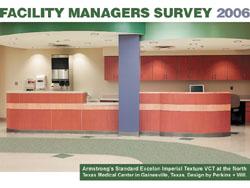Facility Managers Survey - December 2006
By Maurie Welsh O'Neill
It’s been two years since we’ve surveyed the nation’s leading facility managers, and while the economic landscape—and more specifically, the commercial marketplace—has dramatically changed some aspects of their work, some things never seem to change.
What’s new in this year’s survey? On the one hand, the commercial market has finally come back, and we’re seeing stronger—although still cautious—increases in project budgets, with far less emphasis on pricing as a major priority. We’re also seeing stellar increases in the use of carpet tile; many respondents say they are “in the process of switching from broadloom to modular.” And while a healthy percentage of those surveyed—27%—still report using more broadloom than last year, we’re also seeing the continued expansion of employee spaces where hard surface flooring is installed. Perhaps most interesting, results show an impressive rise in the importance placed on the contract dealer in the facility managers’ world.
On the other hand, what hasn’t changed in this year’s survey is that the same old problems, like poor installation, product quality and maintenance, are still top challenges in the facility managers’ work. As a group, the respondents also continue to distinguish themselves from their A&D counterparts with a very different collective attitude about certain things. The most dramatic point of contrast between the two groups: their attitude about color and style. One of the top items on the facility managers’ Wish List is for manufacturers to retain discontinued styles and colors so they can easily replace and maintain their floors longer, while the Top 250 designers can’t wait to be shown new looks and colors and, conversely, become impatient, disappointed and often frustrated with products that look old or dated.
While we’ve seen the general commercial landscape turn around for the better since the last survey in 2004, just how far has the market come?
To measure that, we decided to go back further and compare this year’s results to 2000, a time when the commercial marketplace was at the top of its game; a time when business was so robust that in many top corporations buying was dominated by designers who had been hired away from the Top 250 design firms.
THE FACILITY MANAGERS’ WORLD: THEN AND NOW
This year’s respondents, like those in past surveys, buy floorcoverings nationwide for corporations and facilities that are primarily involved in the corporate, education, retail, government and healthcare sectors, in that order. The most fundamental difference between the survey results today and those six years ago is in the respondents themselves. This year’s respondents have a greater concentration of power than ever before, perhaps due to the rash of corporate cutbacks we saw during the economic slump. Collectively, they have virtually all the buying power and all the responsibility. A staggering 95% say they alone are responsible for the square footage of the buildings they manage. In 2000, just 70% had sole responsibility.
While it’s been clear from past surveys that the facility managers have always carried the weight of enormous responsibility for the massive properties they manage, today’s respondents are carrying even more. The percentage of inhouse committees, which traditionally shared, or in some cases took over, final buying decisions was less than a third of what it was in 2000, leaving the bulk of the decision-making process to rest on the facility managers’ shoulders alone (that figure nearly doubled since 2000.)
As a group, the facility managers also have a more focused core competency, reporting much stronger backgrounds in facility planning and related construction fields, in contrast to the stronger A&D backgrounds we saw in 2000. It’s obvious that things have changed since the days when inhouse and/or outside designers influenced the facility market, as you can see in the results below:
Interestingly, while the total number of buildings the top facility managers oversee hasn’t changed too much in the last six years, the total square footage of those buildings has decreased. This is no great surprise, considering the nationwide sweep of real estate sell-offs after the downsizing of corporate America, which began shortly after the survey we took in 2000.
Perhaps the biggest disparity in the world of the facility manager between now and six years ago has been caused by the dramatic changes in the economy. While the facility managers reported a healthy remodeling market, figures for new construction are markedly low. If we look at new construction versus remodeling back in 2000 compared with those markets now, a far greater number of respondents today—a disturbing 27%, compared to just 10% in 2000—reported absolutely no new construction in the past 18 months. Moreover, projected figures for the next 18 months are about the same.
On the bright side, though, a respectable 64% majority this year reported new construction projects in one to ten buildings, a favorable comparison to the 51% reported back in 2000 for that same number of new projects.
Another positive sign: In the past 18 months, the majority of respondents say that staff sizes and budgets have either increased or remained the same.
For complete survey results, see the December 2006 issue of Floor Focus Magazine.
Copyright 2006 Floor Focus Inc
Related Topics:Coverings
